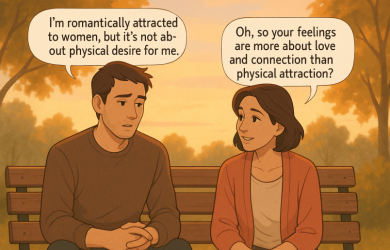What Is Heteroflexibility? 10 Identifiable Signs

Unlock Daily 30-Sec Tips for a Happier Relationship
👉 Subscribe FREEKey Takeaways
Marriage.com AI Quick Summary
To be free to love who we want regardless of gender, sexuality, labels or judgment is true freedom. Don’t let yourself be constrained by language; instead, embrace what it means to be you. Let’s see if the answer to “what is heteroflexible” resonates with you.
What is heteroflexible?
Regardless of whether you resonate with the heteroflexible flag or any other one, the idea is that everyone should be able to find what works for them. We are all individuals and no one should have to suffer judgment.
As therapist Michael Toohey explains in his article on The Alphabet Soup of Sexual and Gender Diversity, we’ve previously seen women liberating themselves in the 70s. Then came the pride community and many more, creating the LGBT community, which keeps expanding.
An important question people often ask: “is a heteroflexible part of the LGBTQ community”? If you go by the letters, then technically, no. Then again, some groups try to include everyone and you’ll find a + added to the letters.
Nevertheless, the heteroflexible meaning is slightly controversial. Many LGBTQ people feel that it’s simply a way for heterosexuals to shun the taboo that’s often still associated with being LGBTQ.
So, what is heteroflexible? In some ways, it’s simply someone who’s straight but is willing and able to adapt to circumstances and partner with the same gender. In other ways, it’s a differentiator from being bisexual, which feels too constrictive.
Then you have the queering heterosexuality meaning, which is slightly different. The word queering comes from queer, which originally meant strange or odd. In this case, it’s a challenge to heterosexuality. In other words, defying heterosexuality as a norm.
As this encyclopedia article on Queering, Queer Theory, And Early Modern Culture continues to describe, queering is the act of challenging traditional homo/hetero binarism. This is often why heteroflexibles prefer that term.
Essentially, they may not identify as a bisexual as they feel more at home somewhere on the spectrum between homosexual and heterosexual.
So, what is heteroflexible? It’s a freedom of choice and openness to possibilities as they arise.
What is the difference between heteroflexible and bisexual?
The heteroflexible meaning is often confused with bisexual. After all, if you’re switching between genders, isn’t that bisexual? There’s a subtle difference though.
Language itself is subtle; some words ring true for some but not others. The word bi can be too close to 50-50 for many, whereas hetero in front of flexible implies a certain leaning towards the hetero side of things.
Then again, others feel that the difference is very fluid and will identify with both words. In the end, people don’t and won’t fit into boxes or labels. The idea is to find the group and network that feels right for you.
Whether you’re heteroflexible or bisexual shouldn’t matter to others. But what might matter is what resonates for you such that you feel included and respected. So, get to know the words and find the one that works for you but never forget your uniqueness.
10 ways to identify heteroflexibility
What is heteroflexible if not being open to possibilities? These can come up in various ways, as suggested below.
Remember that this list isn’t exhaustive. You might have your own definition and that’s perfectly normal too.
1. Sometimes experiment with the same gender
You might feel mainly straight but still experiment with those from the same gender. In those cases, how do you feel? Does it feel right and fun? If so, perhaps this is you.
Interestingly, this study on the differences between heteroflexibility and bisexuality shows that as a heteroflexible, you’re more likely to get together with the same gender spread out over a lifetime. In other words, you still predominantly focus on the opposite gender.
Related Reading: Few Things You Wanted to Ask About Lesbians Sex
2. Mostly into one gender but not always
Another way of defining heteroflexibility is that you generally get together with the opposite gender but stay open-minded about being with the same gender. It then comes down to personality and circumstances.
Some heteroflexibles might decide not to act on their attraction to another gender, but it’s still there. Alternatively, they might never have been with the same gender, but they feel it might happen one day.
3. Comfortable being straight with fluid lines
What is heteroflexible if not fluidity? Of course, sexual fluidity covers all terms but heteroflexible nicely fits under that umbrella.
The term “sexual fluidity” was coined by psychologist Lisa Diamond. While heteroflexibility refers to being flexible at the moment, fluidity can take place over a lifetime. In essence, nothing is fixed and preferences can change.
Moreover, as this article by Lisa Diamond on gender fluidity shows, gender identity and gender expression can move along the binary male/female spectrum. All this greatly impacts well-being and is necessarily linked with what sexuality you associate with.
If you are unsure what fluid or flexible means to you, feel free to reach out to individual or couples counseling. They’ll guide you to connect with yourself and discover the right language for you.
Find out more about sexual fluidity and the myth of being “born this way” in this video interview with Lisa Diamond:
4. You don’t want to exclude your gender
If the term heteroflexible sounds right to you, you’ll have a preference towards the opposite gender, but you don’t want to close the doors to the same gender.
Understanding what is heteroflexible lies in keeping both doors open but having a slight preference for the opposite gender.
5. Previously had fun with the same gender
Perhaps you had fun with someone who associates with being the same gender as you in the past? It might have been a one-off but you can still imagine a future with a similar scenario. In that case, heteroflexibility might suit you.
So, what is heteroflexible? It’s where the lines between hetero/homo merge and people adapt definitions as feels right.
Related Reading: 6 Stages in Your Gay Relationship
6. Other descriptors don’t quite fit
For many, it’s important to differentiate between whether they’re heteroflexible or bisexual. That’s because the term bisexual often feels too much like fitting people into a box.
They feel it’s an either/or choice rather than a choice of hetero and something else.
7. Curious about the same gender
Another way of looking at the question “what is heteroflexible” is to think of it as a curiosity.
Some heteroflexibles will never act on that curiosity; others are straight but act on the curiosity to be with the same gender.
8. You’d give it a go with certain people
Heteroflexibility is about adapting to situations and going with the flow of desire.
They don’t feel restricted by sexual desire for one or other gender. It’s more like being in the flow with people and what works at the moment.
9. Dating and having fun are equally valid
So, what is heteroflexible? It’s somewhere between dating and fun. On the one hand, you see yourself as straight and date the opposite gender to find your ideal partner.
Alternatively, you have fun with the same gender while ensuring that everyone is clear about where they stand.
Related Reading: 15 Signs You are Intellectually Compatible With Your Partner
10. Fluidly straight
If you associate with the six colors of the heteroflexible flag, you’re somewhere between straight and bisexual. Your core experience is heterosexual relationships but you sometimes have same-sex partners.
The best part is that you’re free to interpret what “fluid” looks like for you and where you feel most comfortable along the spectrum.
Some commonly asked questions
Some key questions may come into your mind regarding heteroflexibility. Here is one such question that can clear some of your doubts.
How common is heteroflexibility?
According to Nicole Legate, an assistant professor of psychology at the Illinois Institute of Technology, around 15% of the population call themselves heteroflexible. Her article on heteroflexibles summarizes her research.
She also goes on to say that such individuals also face unfair health treatment due to judgment and prejudice.
More research seems to be needed but regardless of the answer to the question “is heteroflexible part of the LGBTQ community,” we still have a long way to go to make everyone feel welcome and equal.
Stand proud as a heteroflexible
In summary, what is heteroflexible? It’s someone who is mainly straight but sometimes attracted to the same gender without identifying as bisexual. They feel they can move more fluidly along the line between straight and bisexual according to the situation and phase of life.
With the evolution of sexual and gender identity, many have found groups they resonate with. For others, it can feel daunting to find the right word that suits them. Contact individual or couples counseling if you feel lost and confused about who you are and want to be.
Everyone deserves to live a life where they can freely express themselves regardless of preferences. Feel free to explore what works for you.
 Tips
Tips
Write your tip or submit a video tip
All tips are reviewed before the publishing.
Share this article on
Want to have a happier, healthier marriage?
If you feel disconnected or frustrated about the state of your marriage but want to avoid separation and/or divorce, the marriage.com course meant for married couples is an excellent resource to help you overcome the most challenging aspects of being married.
Related Articles
Related Quizzes
Unlock Daily 30-Sec Tips for a Happier, Healthier Relationship
👉 Subscribe FREE on YouTube We'd love your feedback!
We'd love your feedback!
 Expert Q&A
Expert Q&A
Ask your question related to this topic & get the support you deserve from experts.
















 Thanks for your feedback!
Thanks for your feedback!